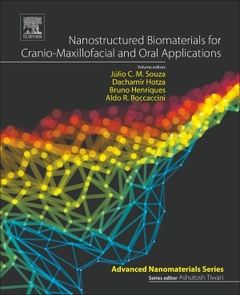Description
Nanostructured Biomaterials for Cranio-Maxillofacial and Oral Applications
Micro and Nano Technologies Series
Coordinators: Souza Júlio C. M., Hotza Dachamir, Henriques Bruno, Boccaccini Aldo R.
Language: English
Subjects for Nanostructured Biomaterials for Cranio-Maxillofacial and...:
Keywords
Additive manufacturing; Bioactive ceramics; Bioactive ceramics; Bioactivity; Bioceramics; Biomaterials; Biotribocorrosion; Bone healing; Composites; Corrosion; Craniomaxillofacial implants; Craniomaxillofacial; Debris; Degradation; Dental implants; Dental restorations; Functionalization; Functionally graded materials (FGMs); Functionally graded nanobiomaterials (FGNB); Graft materials; Hierarchical porosity; Implant; Implant-bone interface; Long-term implants; L-PRF; Nanomaterials; Nanoparticle; Nanoparticles; Nanotechnology; Osseointegration; Particles; Peri-implant osteolysis; Peri-implantitis; Platelet-rich fibrin; Polymers; Porous ceramics; Resin composites; Scaffolds; Tissue engineering; Tissue healing; Titanium; Titanium surface; Tribocorrosion; Wear; Wear-corrosion debris
238 p. · 19x23.3 cm · Paperback
Description
/li>Contents
/li>Biography
/li>Comment
/li>
Nanostructured Biomaterials for Cranio-maxillofacial and Oral Applications examines the combined impact of materials science, biomedical and chemical engineering, and biology to provide enhanced biomaterials for applications in maxillo-facial rehabilitation and implantology. With a strong focus on a variety of material classes, it examines material processing and characterization techniques to decrease mechanical and biological failure in the human body. After an introduction to the field, the most commonly used materials for cranio-facial applications, including ceramics, polymers and glass ceramics are presented. The book then looks at nanostructured surfaces, functionally graded biomaterials and the manufacturing of nanostructured materials via 3-D printing.
This book is a valuable resource for scientists, researchers and clinicians wishing to broaden their knowledge in this important and developing field.
1. Current state of nanostructured biomaterials for oral and cranio-maxillofacial rehabilitation 2. Nanosructured surfaces of cranio-maxillofacial and dental implants 3. Degradation of titanium surfaces 4. Systemic and local adverse effect of nano-scale degradation products on peri-implant tissues 5. Nanostructured polymer matrix composites for oral and cranio-maxillofacial rehabilitation 6. Nanostructured biocompatible ceramics and glass-ceramics 7. Platelet-rich fibrin to incorporate bioactive graft materials 8. Nanostructured biomaterials embedding bioactive molecules 9. Functionally graded nanostructured biomaterials (FGNB) 10. Additive manufacturing of nanostructured bone scaffolds
Dachamir Hotza is a Full Professor at the Federal University of Santa Catarina (UFSC), Brazil. He belongs to the Research Group on Ceramic Materials and Composites (CERMAT) and he is currently the coordinator of the Interdisciplinary Laboratory for the Development of Nanostructures (LINDEN). He has experience in Materials Engineering with an emphasis in ceramics, working mainly in processing, experimental design and nanotechnology.
Bruno Henriques is a materials and engineering professor at Federal University of Santa Catarina (UFSC), Brazil, and is research fellow at MicroElectroMechanical Systems research center (CMEMS-UMinho), University of Minho, Portugal. He holds a Ph.D. in Mechanical Engineering and has done post-graduate work in Business Administration. Bruno has co-authored a patent, authored several papers published in international scientific journals, and has participated in several national and international conferences. His research interests are in the fields of powder metallurgy, stress analyses, laser materials processing and functionalization, functionally graded biomaterials and composites for biomedical applications, particularly to oral and cranio-maxillof
- Explores the techniques used to apply nanotechnology to biomaterials for cranio-maxillofacial and oral applications
- Bridges the gap between fundamental materials science and medicine
- Shows how nanostructured biomaterials respond when implanted in the human body




